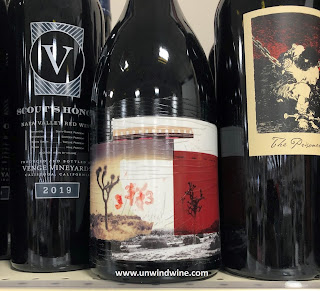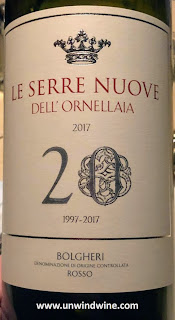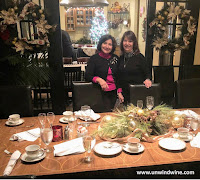Christmas Family gathering features special family birthyear and celebration wines
The entire family gathered for a festive Christmas celebration with gifts, food, holiday treats and of course, some special celebratory wines. As we've written in these pages, over the years, we've collected a horizontal selection of birthyear wines for each of our children. We served those special vintages in large format bottles at their weddings and other gala celebrations.
We still hold several bottles of those wines that are getting on in years approaching or surpassing their drinking ageworthiness and drinking windows.Tonight, at forty years, we decided its time to open these remaining vintage wines and pulled from the cellar some of the most ageworthy labels that remain. The premier bottle we opened was Château Lafite Rothschild 1981. We also opened a Château LaGrange St Julien from the same vintage.
Château Lafite Rothschild Pauillac 1981
We visited the Château Lafite Rothschild estate during our trip to the Bordeaux region in 2018. While we focused on touring St Julien producers, we also stopped by some of the notable estates in nearby appellation of Pauillac that we own and collect. It was a delight and reverent experience to walk the grounds and adjacent vineyards of the legendary historic estates of the Pichons, Lynch Bages and Lafite Rothschild.Château Lafite Rothschild is one of the five First Growth Bordeaux, and one of the most famous and collected wines in the world.
We opted to open this label from our cellar collection as well as a lesser fifth growth that will most likely be closer to the end of, or further past the end of its drinking window. To our dismay and delight, both bottles were still presentable and holding their own, albeit clearly being in their final stages of their drinkability.
Sadly, of all the estates we visited, only one, Lafite Rothschild had security personnel come out and confront us and order us off the property. While we deeply respect their property rights and sovereignty, it made an impression of in-hospitality and un-welcomeness, such that we will avoid the label from our collecting, buying and tasting in the future. While Lafite is legendary, there are many alternative labels available to support.
The Lafite Rothschild estate sits outside the town of Pauillac on the border of the appellations of Pauillac and St Estephe, on the main D2 route heading north as you exit the appellation and enter the adjoining St. Estephe.
The Chateau is surrounded by nearly 280 acres of vineyards that are well-drained and well-exposed, with soil made up of fine deep gravel, mixed with aeolian sand on a subsoil of tertiary limestone. The vineyards are divided into three sites: the hillsides around the Château, the adjacent Carruades plateau to the west, and ten+ acres to the along the highway to the north in neighbouring Saint Estèphe.
The vineyards are planted to Cabernet Sauvignon (70%), Merlot (25%), Cabernet Franc (3%) and Petit Verdot (2%). The average age of the grapevines is 39 years old but fruit from vines younger than 10 years old are not used in the Grand Vin. This means that the average age of the vines used in the Grand Vin (Château Lafite Rothschild) is closer to 45 years. The oldest plot, called “La Gravière , was planted in 1886.
We have been collecting and tasting this legendary label for significant vintages since the 1970's, our anniversary and birthyear vintages dating back to our 1974 anniversary, and this remains one of the oldest and last remaining bottles in our collection of 'collectables'. I still remember opening the 1974 vintage back upon release and then for our a couple of milestone anniversaries at 25 years and others.
This was awarded 91 points by Robert Parker's Wine Advocate.
Back as early as 1997, Robert Parker wrote that "This wine is close to full maturity, but it is capable of holding for another two decades."
Parker wrote: "It reveals the classic Lafite bouquet of red and black fruits, cedar, fruitcake, and tobacco-like aromas. In the mouth, this medium ruby/garnet-colored wine displays a delicacy of fruit and sweet attack, but subtle, well-defined flavors ranging from tobacco, cigar box, cedar, and fruitcake. This is a savory, soft Lafite-Rothschild that is pleasing to both the intellect and the palate. (RP) (12/1997)"
Son Ryan took great care to extract the cork completely intact using an 'ahso' two pronged cork puller. He double decanted it with a strainer to separate the black sediment.
The color was dark garnet color with just a slight amount of bricking on the edges. The slight funky nose burned off after a short period to reveal bright cherry aromatics. Medium bodied, smooth, polished, delicate black berry and black cherry fruits with accents of cigar box, cedar, hints of leather and graphite with a tangy acidic lingering finish.
RM 90 points.
https://www.cellartracker.com/wine.asp?iWine=12987
Château LaGrange St Julien 1981
We also pulled from the cellar another 1981 vintage Bordeaux to consume before it is too late in its drinking window.
We also visited the LaGrange estate, outside the village of St-Julien-Beychevelle during our visit to Bordeaux in 2019. It sits further 'inland' from the Gironde River estuary, not far from the adjacent estates of Château Gruaud-Larose and Château Branaire-Ducru that we toured during our visit.
The iconic Château that is recognized from decades of labels is more picturesque than expected or imaginable as it looks out on a small lake/pond as one approaches the estate.
The estate has turned over and undergone substantial improvements over the years and the quality of product is vastly improved today.
Château Lagrange was founded and can be found mentioned as early as the 13th century.
The reputation of the cru was established in the 18th century by the families of Brane and Arbouet, succeeded by Jean Valère Cabarrus, who built the Tuscan Tower estate in 1820.
In the 18th century it found favour with the American ambassador Thomas Jefferson, who placed it 3rd in his rank of personal favourites. In 1842, Château Lagrange was bought and redeveloped the property modernizing the facilities and extending the vineyard and classified third cru within the Grand Cru Saint-Julien in 1855.
After a series of crises between the 19th
and 20th centuries (phylloxera, world wars), the property has risen from
the ashes, notably thanks to the Suntory family who bought it in 1983
and undertook a large-scale renovation.
The property was taken over by the Japanese spirits producer Suntory in the mid 1980's. They made substantial improvements to the property and facilities through 2008 and modernized the entire winemaking facilities and cellars in 2013 which should no doubt result in increasing improvements and quality of the wines. Suntory also took over and made substantial investment in additions and improvements to nearby Château Beychevelle which we also toured while in the area.
Read more at:https://www.thewinecellarinsider.com/bordeaux-wine-producer-profiles/bordeaux/st-julien/lagrange/
Read more at:https://www.thewinecellarinsider.com/bordeaux-wine-producer-profiles/bordeaux/st-julien/lagrange/
Château LaGrange St Julien Bordeaux 1981
This is the oldest of several vintages of this wine dating back to this birth year
vintage from Erin's vintage release in the early eighties.
Château LaGrange vineyards span nearly 300 acres and rise to an elevation of 24 meters, the highest altitude in the St Julien appellation. The vineyards are planted to 70% Cabernet Sauvignon, 25% Merlot and 5% Petit Verdot for the reds, and 80% Sauvignon Blanc, 10% Sauvignon Gris and 10% Sémillon for the whites. The vineyards have that classic St Julien pebble soil.
This release is a blend of 65% Cabernet Sauvignon, 28% Merlot and 7% Petit Verdot.
Earlier in its life this release was rated 92 points John Gilman, James Suckling, Wine Spectator and Wine Enthusiast, and 90 points by Wine & Spirits and Robert Parker. Like the Lafite above, we also obtained this upon release and have kept it in our cellar since. As such the bottle and label were in pristine condition - the bottle fill level being top of neck, the label and foil being in best expected condition for their age. Unlike the Lafite however, the cork of the LaGrange was partially saturated and crumbled upon extraction. Even with the 'ahso' two pronged cork puller, it came apart and required a combination ahso and corkscrew to remove completely.At forty years of age, this was amazingly holding on to its color and what remained of its structure and fruits albeit diminished to being minimal, it was still presentable and while modest, was pleasant drinking, especially considering its age.
Like the Lafite above, Ryan double decanted this. It showed dark garnet colored, medium body with black berry and black cherry fruits turning to leather, tobacco and notes of black tea and tangy acidity on hte modest finish.
RM 88 points.
https://www.cellartracker.com/wine.asp?iWine=363605
https://chateau-lagrange.com/en/
https://www.ugcb.net/en/chateau-lagrange
Château Mouton Rothschild Pauillac 1985
This is tribute to son Sean's birthyear, and the recent birth of his and Michelle's daughter Lavender. The classic Mouton Rothschild artist label of the 1985 vintage features an surrealist impressionist painting of demure young maidens gazing on bunches of grapes, painted by Belgium born Flemmish Expressionist Paul Delvaux.
We only hold this vintage of this legendary first growth label in a small format half bottle so we held off opening it today, but presented it to the new parents to hold and open together on a suitable occasion of their choosing.
I write often in these pages about bottle sizes, large and small, here is an example of a small format bottle, suitable for an intimate tasting for two!
Like the other bottles we acquired this upon release and have been holding in our cellar ever since. The image shown is taken from a large format double magnum of this release, to better show the artist painting as rendered on the label.
https://www.cellartracker.com/wine.asp?iWine=1582
https://www.chateau-mouton-rothschild.com/label-art/discover-the-artwork/paul-delvaux#
We also opened this hearty full throttled Aussie Shiraz Cabernet Blend for enjoyment by the group.
Mollydooker Enchanted Path Cabernet Shiraz 2007
I write about the Mollydooker branding and history in more detail in this blogpost.
Their portfolio of cartoonish labels are a family favorite and we open their premium labels, Enchanted Path and Carnival of Love on many family special occasions.
Mollydooker is the handiwork of the (former) husband-and-wife
winemaking team of Sarah and Sparky Marquis. Prior to starting their own label the pair produced under the Marquis Philips
brand in partnership with their distributor Dan Philips. Previously,
they produced award-winning wines for Australian producers including Fox
Creek, Henry’s
Drive, Shirvington, and others. The term Mollydooker is Australian
slang for a left-handed person as both Sarah and Sparky Marquis are
left-handed.
Since 2005, they focused exclusively on making their own exuberant wines which
include a range of Shiraz labels and a variety of Shiraz/Cab/Merlot blends, as well as some adventuresome
white wines such as The Violinist, a Verdelho varietal.
They source their fruit from 116 acres of vineyards at their winery in
McLaren Vale where about 50 percent are planted in Shiraz, with the
rest made up of Cabernet, Merlot, Semillon and Chardonnay. Most of their
wines bear distinctive whimsical and humorous names and labels with
cartoon characters. Never-the-less, many of their wines, while
modestly-priced, Mollydookers are often highly
rated. Their premium label, 'Velvet Glove' Shiraz retails for $175,
however.
RM 92 points.
Robert Parker's Wine Advocate gave this wine a whopping 95 points and wrote in their review: " The 2007 Enchanted Path, a blend of 67% Shiraz and 33% Cabernet Sauvignon, is aged in mostly American oak, 70% new. Purple/black colored, it has a brooding bouquet of spice box, toasty oak, mineral, espresso, black currant, and blueberry. Structured and powerful on the palate, this dense, rich effort requires 5 to 7 years of additional cellaring and will offer prime drinking from 2014 to 2028. 95+ Points (JSM) (2/2009)."
Wine Spectator gave it 91 points and wrote: "Big, ripe and focused, offering a blast of cherry and plum, with a welcome floral note that lasts through the long, vivid finish. Has a touch of spice as the finish lingers against fine tannins. (HS) (10/2008)".
https://www.cellartracker.com/wine.asp?iWine=554810
































